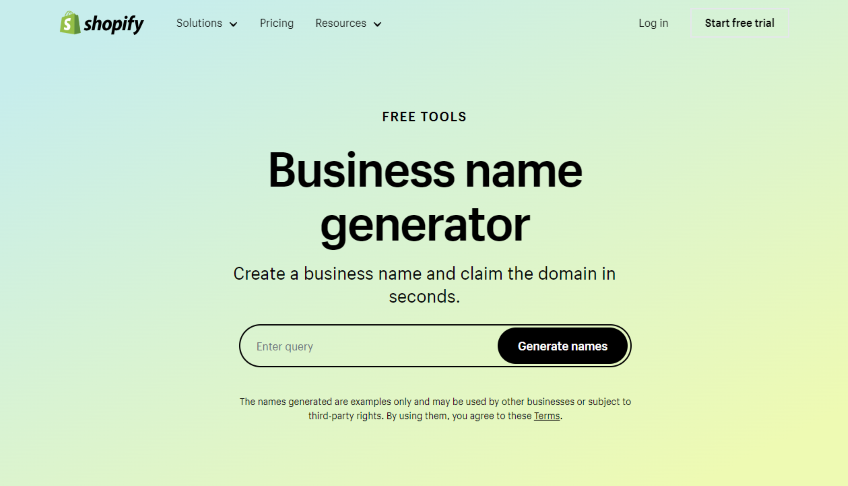So you’ve got a great idea for a new business.
You took the time to write a business plan for your startup. After long and grueling months of conducting market research, coming up with prototypes, and analyzing your competition, you’re finally ready to turn this plan into a profitable business.
You even came up with a plan to raise the funds to get your company off the ground.
But before you can proceed any further, you need to name your startup company.
You may have had an idea or two. But how do you know if that name will work?
Naming your startup may seem minor, but it’s actually one of the most important and undervalued aspects of your business. This name will be attached to your brand image for years to come. You need to get it right from the beginning.
Otherwise, you’ll face some challenges if you try to change your name down the road. That’s a headache you won’t want to deal with.
With this in mind, we wanted to show you how you can simplify this process. These are the top tips to keep in mind when you’re naming your startup.
16 Steps to Name Your Startup
Use this guide as a reference before you finalize your name.
- Keep it short
- Make sure it’s easy to spell
- Don’t restrict growth
- Check the domain name
- Be original
- Say it out loud
- Ask for feedback
- Research social media profiles
- Make it catchy
- Search the Secretary of State records
- Do trademark research
- Make it relevant
- Keep your logo in mind
- Take advantage of brainstorming tools
- Don’t drive yourself crazy
- Make sure you’re happy with it
Step 1 – Keep it short
The name of your business should roll off the tongue.
People shouldn’t have to take a breath midway through saying your name out loud. Just think about some of the brands that dominate worldwide.
Nike. Apple. Walmart.
We found a really interesting study conducted by a UK insurance broker. They discovered that the average length of a company name in their region had 22 characters.

More than half of these businesses fell within the 17 to 24 character mark.
While these are obviously longer than names such as Apple or Nike, they still fall within the lower end of the spectrum, as you can see from the graph.
Your business shouldn’t sound like a sentence. Sure, in some instances, two words might be appropriate. We’re talking about names such as Waffle House or even Quick Sprout. Ha! But both of these names are still short and roll off the tongue.
Most importantly, keeping your name short will make it easier for consumers to remember it, which will help you tremendously with your marketing campaigns.
Step 2 – Make sure it’s easy to spell
Put yourself into the minds of consumers.
Let’s says they hear your brand name somewhere. Whether it’s on TV, the radio, or in a conversation. Next, they search for it online, but can’t find you because they don’t know the spelling – it’s too complicated.
Stick with names that are spelled exactly how they sound.
Even if they see your oddly spelled brand name written somewhere, they may not remember how to spell it when they look for it.
Don’t do anything weird, like using the number 8 to replace the “ate” sound or use the letter “Z” in a place where you should have an “S.”
Step 3 – Don’t restrict growth
Right now, your startup may be focusing on something specific, whether it’s a product, location, or target market.
But that doesn’t mean you should name your business something extremely specific.
For example, let’s say you’re creating a fashion brand selling men’s jeans. Naming your company “Jeans for Men” is a bad idea.
What happens when you want to start making shirts, shorts, hats, or women’s clothing? The new directions no longer fits with your name.
Or let’s say you name the startup based on the location of your first physical store. You may be thinking something along the lines of “Tuxedo Shop of Seattle.” But when you want to open a new location in Chicago or San Diego, you’ll be faced with a challenge.
Instead, name it after something like a street if you want to have some connection to your local area. Just make sure it’s easy to spell.
Step 4 – Check the domain name
So you think you’re ready to settle on a name.
Next, use an online tool, such as Domain.com to see if the domain is available:
We see businesses make this mistake often. A company settles on a name, but someone already has the .com domain. So instead of trying to purchase it, they decide to use another extension, such as .net, .biz, or .org, instead.
We don’t recommend that. Consumers have grown accustomed to associating .com domains with credible and established businesses.
But that also doesn’t mean you should make your domain different from the name of your startup just to secure a .com domain.
My suggestion is this. If your domain name is taken and you can’t buy it, try to come up with a different name for your business.
Step 5 – Be original
You want your brand to be unique. Your name needs to be memorable and stand out from the crowd.
Do your best to avoid common names. “John’s Plumbing.”
How many plumbers out there do you think have that name? We’re willing to bet there is more than just a handful.
You want your name to stand on its own, without any confusion or association with other companies.
Step 6 – Say it out loud
Your name may look good on paper. But what happens when it’s spoken?
Earlier we said names should be easy to spell, but they should also be easy to pronounce.
Make sure that when you say it out loud, it doesn’t get confused with other words. You don’t want it to sound like something that could be inappropriate.
We won’t give you any examples in this instance. We’ll let you use your imagination.
Step 7 – Ask for feedback
You don’t have to struggle alone naming your company.
Sure, you can come up with some ideas and ultimately have the final say. But if you’ve got a team or partners, make it a group discussion.
Write down your ideas. Narrow the list down to five or ten names.
Then reach out to your family and friends. See what they think. If one name by far stands out from the crowd based on that feedback, you should consider it more than the others.
Step 8 – Research social media profiles
This is similar to your domain name search.
You want your branding to be consistent across all your marketing channels. See if certain social media handles are taken.
Here’s an example from Thule. Let’s look at its Facebook page first:

And now let’s check out its Instagram profile:

As you can see, the company uses @thule everywhere.
It may sound simple, but you want to make sure all of this is squared away before you name your startup.
Having different social media handles on each platform will confuse your customers. It’ll complicate your efforts to build brand awareness for your new company.
If your name is available on all social media platforms except for one, reach out to the user and see whether you can purchase it from them, or consider coming up with a new name.
Step 9 – Make it catchy
Your brand name needs to resonate with consumers. It shouldn’t be forgettable.
Even though you’re in the early stages of your business, you should always be looking toward the future and thinking about potential marketing campaigns.
How will this brand name fit with your campaigns? Will it be easy for you to come up with a company slogan that flows well with the name?
You can’t pre-determine whether something will be catchy or not, and there aren’t any tools that can help you with this. But you can still figure it out based on your gut feeling and feedback of others.
Step 10 – Search the Secretary of State records
Once you come up with a name, you’ll need to register your new business.
You’ll probably form an LLC or corporation. In the US, check the Secretary of State records to make sure the name isn’t too close to a business that’s been previously registered.
If the name is too similar, the state may disallow you from registering that name.
Find a lawyer to help you register your new business. They can potentially help you with this research as well.
Step 11 – Do trademark research
You don’t want someone else to be able to steal your name.
Do a search on USPTO.gov to see whether you can trademark it.

This website will provide you with the resources and information you need to know about existing trademarks and the application process for your own trademark.
Step 12 – Make it relevant
Earlier, we talked about picking a name that doesn’t restrict your growth.
But that doesn’t mean you should pick something random or obscure.
Let’s say your startup company focuses on Internet security. Don’t name it “Bunny Ears LLC.”
Is the example a bit extreme? Probably. But you get the point.
Step 13 – Keep your logo in mind
Your brand name will be tied to all your marketing efforts. Keep your logo design in mind as well.
Different color schemes can impact sales. That’s because visuals are processed faster than words. Consumers will remember a name if the logo is memorable.
Think about McDonald’s. The “M” golden arches are iconic.
How will your brand name translate to your logo and will it be recognizable? Ask yourself that when coming up with a name.
Step 14 – Take advantage of brainstorming tools
If you’re stuck on a name, you can use technology to help.
Use a tool such as Namechk to search for domain names and social media account handles. Or try Naminum to choose a name based on specific themes.
But one of my favorite tools is from Shopify:

This business name generator helps you come up with ideas while checking for domain availability at the same time.
You can also take advantage of AI tools like ChatGPT to help you come up with potential names for your new business.
Step 15 – Don’t drive yourself crazy
Picking a name is important. But don’t let it consume your life.
It shouldn’t turn into a six-month project. If you take time to work things out, you’ll be just fine.
Will the name be perfect? Maybe not. But what is?
Don’t keep second-guessing yourself. Go with it if:
- all the pieces line up
- the domain is available
- nobody has the social media handles
- the feedback is good
- you’re able to trademark it.
Step 16 – Make sure you’re happy with it
The name of your startup will be something you hear, say, write, and think about all the time.
If you don’t like the name, don’t use it. This startup is your baby. You wouldn’t name your baby something you don’t like, right?
The same concept applies here. Otherwise, you’ll regret it, and that could impact your behavior and the way you run the business moving forward.
Conclusion
What’s in the name? More than you think.
The name of your startup company will be your new identity. Don’t approach this task haphazardly.
Whether you’re struggling to come up with a name or you have a name in mind but unsure how to proceed, use this guide to help you finalize the decision.
It’s better to take the time and be sure of it now as opposed to trying to change your name in the future.
